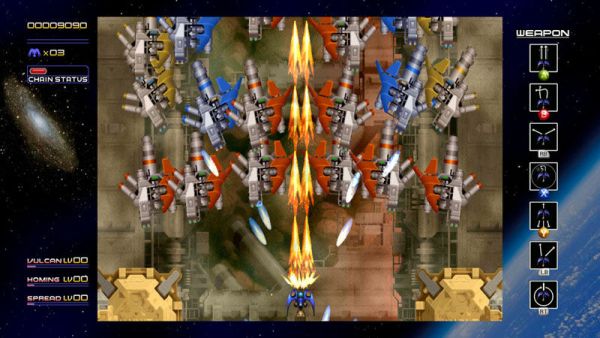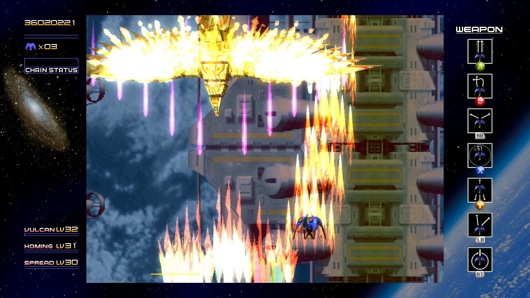

The era of the downloadable console game has been very good to fans of classic gaming. Hard to find titles from the past are released for XBLA and PSN for a relatively low price, with HD upscaling, leaderboards, and other modern features added on. A port of the legendary shooter Radiant Silvergun, long rumored to be in development, has finally become available. Now that the king of shmups is in the wild, does it really live up to its near-mythic status?
Originally developed over a decade ago for Japanese arcades, Radiant Silvergun was also released for Sega's Saturn system. The game never made it to the United States, and this scarcity, coupled with its high quality gameplay, drove the price for an import copy through the roof. As a shmup fan, I've always wanted to play it but never had any way to do so. Now that there is an Xbox Live release, the price and availability are more than managable.
Radiant Silvergun was developed by Treasure, creators of such iconic classics as Gunstar Heroes and Guardian Heroes. Another Treasure XBLA release, Ikaruga, is a sequel of sorts to Radiant Silvergun, and the two games have many similarities. The enemy and boss designs between the two are very much alike, as is the "chaining" system of scoring points. Radiant Silvergun turns many genre conventions upside down; you start with access to a whopping seven different weapons, for example. As you use each one, they level up, becoming more and more effective as you play. Knowing which weapon to use for any given situation is a key to survival.

And surviving the onslaught of enemies is very difficult. The difficulty never quite gets into the "bullet hell" variety, at least not very often, but there's no denying the fact that the challenge is daunting. Pattern memorization and quick reflexes are skills that must be mastered in order to keep progressing through the game. Knowing just when that barrier closes you off, or that wave of fast ships sweeps in on you from nowhere, and being able to dodge precisely without overreacting is crucial to success.
You can't really "metagame" your way through this one, either. There are no unlimited continues, and even on "easy" level, casual shmup fans will die early and often. The two main game modes include arcade and story mode. In arcade mode, you can adjust your number of lives per continue to as many as ten, and you earn additional continues beyond the default three for each hour you play Radiant Silvergun. Story mode is a different animal; you have no continues at all, but instead earn extra lives with additional playtime. The key advantage of story mode is the fact that your weapon upgrade levels carry over when you die. Obviously, this makes things easier, but it will be many hours before you max out your weapons totally. Chances are, you will be grinding the first few levels over and over again. It feels somewhat like an RPG or MMO style leveling treadmill, to be honest.

Thankfully, the game never feels cheap or artificially difficult. When you die, it's because you messed up, not that the game used what feels like a dirty trick to cost you a precious life. Even when you die repeatedly, the game is still fun, if nothing else just for the sheer spectacle. Often, levels are quite short, and boss fights appear quite regularly. The bosses are suitably intimidating, and have plenty of firepower, but there's always a way to win; in fact, there are multiple paths to victory. You can plow right through by concentrating your fire on the boss' central core, or instead choose to surgically destroy every piece in order to gain more points. A third option is to merely survive; bosses self-destruct after a given period of time. In essence, there are many ways to play Radiant Silvergun. You can play quick and dirty to "beat the game" as soon as possible, work on stringing color chains and maximizing boss damage to get high scores, or just grind your weapon levels for a bit here and there. This depth is one way in which the game lives up to its legend.
The enhancements for the Xbox Live release are about what you'd expect. The graphics are enhanced with all sorts of digital voodoo, and look stellar. For the grognards who want the authentic experience, the original, pixelly but somewhat more precise display is available. In addition to the arcade and story modes, there are leaderboards for just about everything. Local co-op was a feature of the original, but for this release, online co-op is supported. In my experience playing online, I wasn't impressed. The game runs at a slower pace, and control feels sluggish and laggy. I wouldn't say it is unplayable, but it's certainly not ideal.
When playing in co-op, player two basically copies the progress of player one. Weapon levels, numbers of lives and continues, and other stats are the same for both players when the game begins. I'd have preferred to see these remain unique for each player's save, so one could concentrate on the vulcan weapon, while the other mastered the homing, that sort of thing. A glaring omission is the lack of saving progress in story mode when playing online. There's really no excuse for this; I suspect it was an unavoidable technical limitation of some sort, because it's a feature that pretty much kills online co-op for all but the most skilled players.
For the most part, Radiant Silvergun lives up to the hype. It's one of the best shmups I've ever played (though I think Ikaruga is a hair better), and I'm thrilled to have access to it at last. The sheer spectacle of the action, the weapon leveling system, the stellar soundtrack, and, yes, even the steep difficulty curve all work together to create something special. The puzzling lack of online story mode save games, and the lack of separate progress for player 2, unfortunately mar the otherwise solid co-op experience. It's still a very enjoyable game to play with a partner, even with these limitations, and fans of the genre should not overlook it.